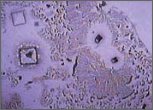Many people believe sea salt is a healthy alternative to table salt, but this is no longer the case. The oceans are being used as dumping grounds for harmful toxic poisons like mercury, PCBs, dioxin and microplastic particles. Reports of oil spills polluting the sea are becoming more frequent. With some 89% of all the sea salt producers now refining their salt, today's sea salt simply isn't as healthy as it used to be. What’s about Pink Himalayan salt?
If you were to look into a microscope at sea salt (pictured below), you would see sea salt has irregular and isolated crystalline structures disconnected from the natural elements surrounding them. Thus, however many vital minerals it may contain, they cannot be absorbed by your body unless the body expends tremendous energy to vitalize them.
Your body's net gain is small compared to the great loss of energy.

Because the crystalline structure of crystal Himalayan Pink salt is balanced (picture below), it is not isolated from the 84 inherent mineral elements, but is connected to them in a harmonious state. This means the energy content in the form of minerals can be easily metabolized by your body. When you use this salt, it has a vital energetic effect.
Your body gets an ample net gain with little energy loss.

Mined salt, or rock salt, is also a poor substitute for Himalayan Pink Salt. While natural rock salt comes close to being intact and is more valuable than industrial table salt, from a biophysical as well as biochemical perspective, it holds little value.
The elements contained in rock salt lack sufficient compression to be included in the crystal web, but are only attached to the surface and in the gaps of the crystalline structure. It is the considerable pressure that brings the elements to a colloidal state – where your cells can readily absorb them.
The valuable elements found in rock salt are useless, because they are less absorbed.

